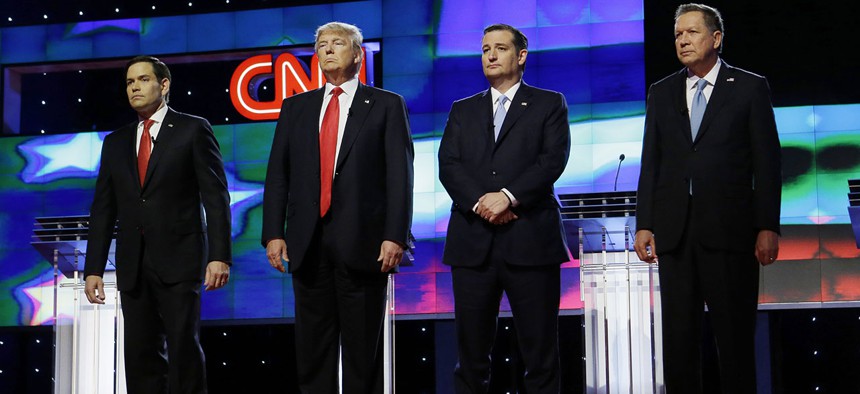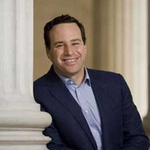American Conservatives Face a Difficult Choice in 2016
They can back Trump, or run a candidate of their own—but either way, they’ll bring this era of American politics to a close.
The accelerating likelihood that Donald Trump will win the Republican presidential nomination outright thrusts an agonizing dilemma on Republican politicians. Leave aside their own personal feelings about Trump. The most likely consequence of a Trump nomination is a severe Republican defeat in November, and not a defeat for Trump alone. Some significant number of Republicans just won’t vote for Trump. When people don’t want to vote for the top of a ticket, they often stay home altogether, dooming every close race lower down on the ticket.
Republicans have Senate seats at risk in Florida, Illinois, New Hampshire, Ohio, Pennsylvania, and Wisconsin—sufficient to put the Republican majority in question. The House looks safer, as does the Republican hold on state governments, but who knows? Trump is most objectionable to the most reliable and loyal Republican voters, exactly the kind of people who vote Republican for every office all the way down to county commissioner. Perhaps the very most reliable and most loyal will show up no matter what, skip the top line, and otherwise vote the straight ticket. Or perhaps not.
So talk is rising in the Republican world of some kind of independent candidacy, using some minor-party ballot line. It’s hoped that such a candidate—Senator Ben Sasse from Nebraska? Mitt Romney?—would offer anti-Trump Republicans a reason to show up to vote, and thus save the Senate.
That’s the hope. But the third-party solution has risks, too, bigger risks than anyone is calculating right now.
When people bolt their party, the party changes behind them.
Take, for example, the Progressive Republicans. When they bolted the party to follow Teddy Roosevelt’s independent campaign in 1912, they left conservatives in control of the Republican apparatus. Before 1912, it was very much an open question whether the reformist movements of the 20th century would find their home in the Republican or Democratic Party. After 1912, the most important of those reforms would be carried out at the federal level by Democrats, and opposed by Republicans. When Republicans regained the White House in 1920, it would be under the leadership of the man who’d delivered the nominating speech for William Howard Taft at the 1912 convention. The young people who’d looked to Teddy Roosevelt for change in 1912 would in many cases end up as followers of his cousin Franklin in 1932—most notably, the former Bull Moose who ran most of the early New Deal, Interior Secretary Harold Ickes.
Or consider the example of George Wallace. When he bolted from the Democratic Party in 1968, he offered downscale Southern whites the same political mix they’d supported since Reconstruction: populist economics joined to racial conservatism. His bolt was intended to frighten national Democrats to jettison Kennedy-Johnson liberalism and return to something like the old ways. Instead, the 1968 election confirmed the Democrats as the party of black interests and black votes. Wallace accelerated the great political realignment of the 1970s: minorities and highly educated whites moving into the Democratic party; downscale whites leaving it, especially in the South.
Or take Ross Perot’s 1992 insurgency. The Republican Party dominated presidential politics from 1968 through 1988, winning every election except 1976, and gaining in 1972 and 1984 two outright landslides: 60.7 percent and 58.8 percent of the vote, respectively.
But in 1992, Perot smashed the old Nixon-Reagan coalition. He won over 20 percent of the vote in the state of California—a solid Republican state before 1992, and never again thereafter. His very best state—Maine—had likewise been a Republican stronghold before 1992, and would never vote Republican again. Perot exposed Republican vulnerabilities in the new purple states of the South, notably North Carolina, where Bill Clinton finished within less than one point of George H.W. Bush.
The white voters most resistant to the Perot message were those who attended church most often. Post-1992, the GOP redefined its base vote in religious rather than economic terms. And while that redefinition reestablished the party’s competitiveness, it also denied it the majority support it had enjoyed pre-Perot. Only once after 1992, in 2004, would the Republican win more than 50 percent of the vote in a presidential election—and then only barely.
Which brings us to the present day.
An anti-Trump bolt will appeal to ideological conservatives, to libertarian leaners, and to the most religiously observant Republicans: what Republican strategist Grover Norquist has called the “leave us alone coalition.” What happens if that coalition does not run strongly in 2016? If it picks up something more like John Anderson’s 1980 6.6 percent of the vote, rather than Ross Perot’s nearly 20 percent? John Anderson ran as a liberal Republican who could not accept Ronald Reagan’s leadership—a group we have not heard much from since 1980. That’s the risk of political tests of strength: Sometimes you lose, and afterward nobody fears you ever again.
A “true conservative” independent race for president may offer anti-Trump Republicans a way to vote their consciences without endorsing Hillary Clinton. But it may also expose “true conservatism” as a smaller factor in U.S. presidential politics than it’s been regarded as since the advent of the Tea Party. And it will leave the instrumentalities of the GOP in the hands of people who were willing to work with Trump, and whose interest post-Trump-defeat will be in adapting his legacy to the future rather than jettisoning it.
Which is not to argue against it. Sometimes a political movement must and should go down fighting. Many conservatives will feel that way about opposing Trump in November 2016. The alternative—ticket-splitting between Hillary Clinton at the top and Republicans down-ballot—also carries daunting dangers. But whatever is decided by conservatives who refuse to board the Trump train, that decision is best made without illusions and false hopes. This election closes a long period in American politics. Whatever comes next, that period will not return.
NEXT STORY: Play of the Day: Trump Rally or Fury Road?




